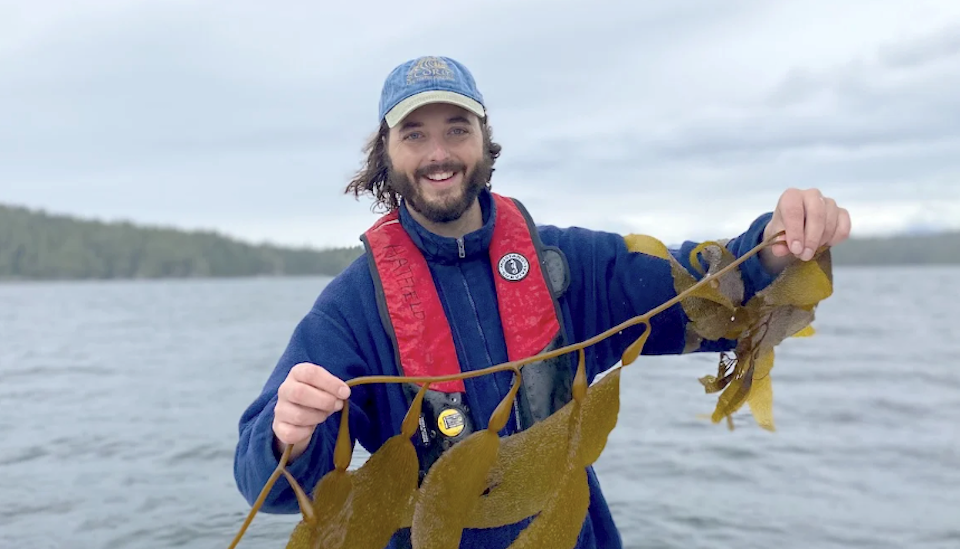B.C.’s critical kelp forests withered as climate change has triggered marine heat waves along the entire West Coast in recent years.
But exceptions to the rule may provide insights helpful to saving and restoring our underwater forests, said Samuel Starko, a University of Victoria researcher.
Kelp forests don’t all respond the same way to incidents of extreme marine heat, such as the two-year event starting in 2014 ominously known as “The Blob,” Starko said.
During the blob event, water temperatures along the shoreline of Barkley Sound rose by as much as 3 C, sometimes hitting upwards of 20 C, temperatures more typical of southern California waters, Starko said.
Kelp populations in the sound's inlets and fiords off the West Coast of Vancouver Island vanished at 40 per cent of the sites analyzed due to the abnormally warm waters, a study led by Starko examining historical data from the Bamfield Marine Sciences Centre showed.
Kelp forests, which stretch across more than a third of the world's coastlines and thrive in cooler water, are one of the marine habitats most threatened by global warming, Starko said.
“Kelp forests are really among the most productive and abundant ecosystems that we have in coastal British Columbia,” he said.
“So understanding how and where these ecosystems are vulnerable to warming and to heat waves can help us better predict future changes and also improve our ability to conserve and restore these habitats.”
Kelp forests act as fish nurseries for important species such as salmon, rock cod and lingcod and as habitat for fish of all kinds and marine mammals, such as seals, sea otters. Grey whales also rely on kelp forests for abundant krill.
The impacts on kelp in the warmer inner coastal waters were dramatic, and kelp populations haven’t recovered to date, especially given a second less-dramatic blob hit the coastline again in 2019.
Perhaps unsurprising, kelp forests in the cooler outer coast waters suffered fewer losses. And some populations did survive along the inner parts of Barkley Sound if they were in deeper, cooler water, which experienced a good mixing of water through wind or tides, Starko said.
Unchecked sea urchins chew down kelp forests
But another impact on the survival of kelp forests is sea urchins, which, if unchecked, can devour the marine gardens and leave underwater barrens in their wake.
The blob had a double whammy effect, Starko said. The warmer water also aggravated a wasting disease that has decimated the once ubiquitous sunflower sea star — a key predator of sea urchins.
Without pressure from their traditional predator, sea urchin populations exploded and also negatively impacted kelp.
But the study found kelp forests in deeper, cooler water were more likely to survive if they were growing on a sandy ocean bottom rather than rocky sites typically preferred by urchins, Starko said.
The study’s findings and others like it could help scientists, First Nations, governments and conservation groups collaboratively shape plans to save and restore kelp gardens, Starko said, noting a new hub called the Kelp Rescue Initiative has been set up to try to facilitate such projects.
Keeping sea urchins under control might involve encouraging or protecting the natural expansion of sea otters, which also eat sea urchins, Starko said. Or harvesting sea urchins in areas that would help protect kelp forests, he added.
Also working to identify which types of B.C. kelp are more resistant to warm temperatures and replanting them in areas with ideal conditions that urchins don't find attractive is another possible restoration method, he said.
The diversity of kelp on the B.C. coast is unmatched and provides unique opportunities for research and restoration, he said, adding a quarter of all kelp species are found along the Pacific coast of North America.
“We have this interesting mix of both northern species more typically found in Alaska and southern species found in California,” Starko said.
“That’s why we’re really at the centre of their diversity. Much of their evolution actually occurred (along the West Coast) and they spread from here to the rest of the world.”
But marine heat waves, which feature prolonged, abnormally high water temperatures due to changes in weather patterns and ocean behaviour, are distinct from the atmospheric heat dome and record temperatures experienced by B.C. last summer.
A week or so of extremely hot weather might kill kelp exposed in shallow waters of the intertidal zone, but it wouldn't dramatically impact kelp located in deeper water, Starko said.
"The ocean water didn't actually get as warm as it did during the blob," he said.
There are still many outstanding research questions around kelp along the length of the coast and how marine ecosystems in particular locations are weathering climate change, Starko added.
“I really think of them as being the underwater equivalent of rainforests,” he said.
“And I find that really exciting … to be researching such an important group of organisms that we know so little about.”



